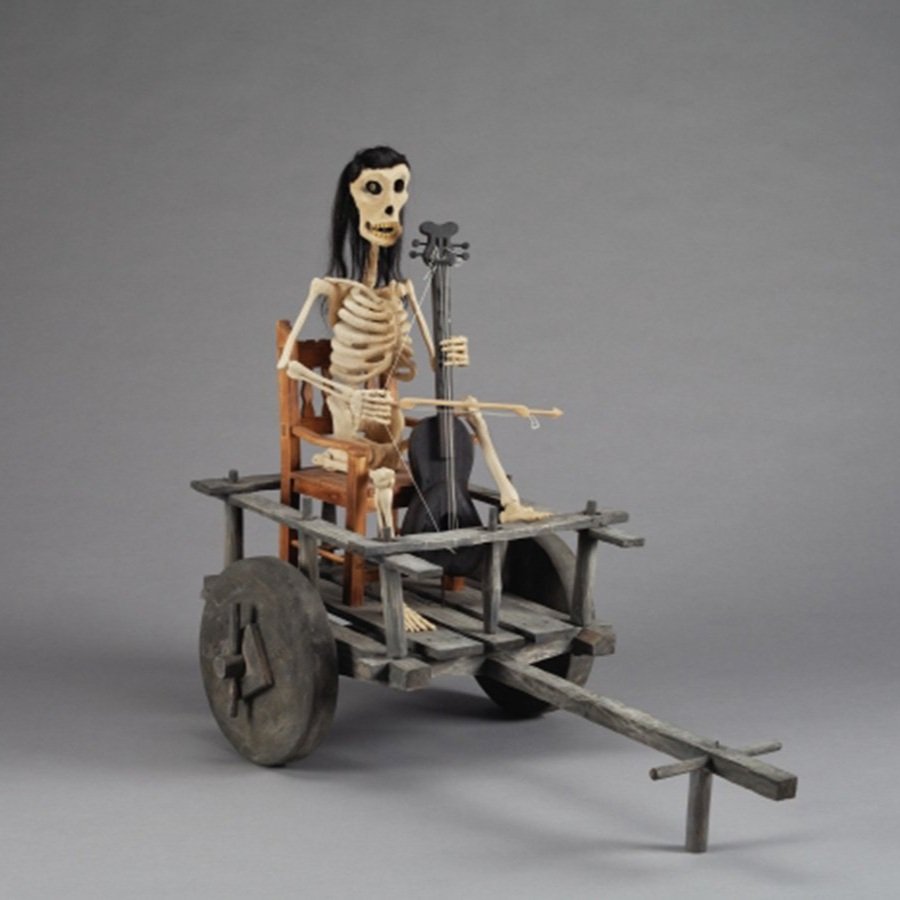Summoning Santa Muerte
A typical representation of Santa Muerte. Photo by Richard H. Grant.
Composer Nicolás Lell Benavides is no stranger to storytelling in his music, always finding “…a way to sketch complete characters in swift sure lines…” according to The Washington Post. He hails from New Mexico, a veritable crossroads of cultural influences, and in his recent work, he’s found inspiration in subjects as varied as a couple’s adoption of a shelter dog in his one-act opera Pepito, to the life and work of labor organizer Dolores Huerta, in a new opera to premiere next year in San Diego. Who better than he, we thought, to create new work for our evocative November 2023 Visitations concerts, coinciding with Halloween and Dia de los Muertos?
Nicolás Lell Benavides. Photo by Vivian Sachs.
In our development process with Benavides, we discussed the creation of a new tone poem in the spirit of other terrifying classics, such as Schubert’s Erlkönig and Dukas’ The Sorcerer’s Apprentice (both of which also appear on November’s program). Both of these works are inspired by the otherworldly poetry of Johann Wolfgang von Goethe, and Benavides’ search led him to a an equally literary and spiritual source, this time from New Mexico: the tale of Doña Sebastiana, the spirit of death itself. Benavides explains the path that led him to this decision:
New Mexico frequently stands at the intersection of many cultures; its isolation having helped preserve some of the folk traditions that might have washed away through assimilation. Rudolfo Anaya, New Mexico’s greatest author, and José Griego y Maestas adapted some of the most popular folk tales in side-by-side English and Spanish with illustrations called Cuentos: Tales from the Hispanic Southwest. Many of them are dark, but the most intriguing of all is the tale of the skeletal Doña Sebastiana, more commonly known as Santa Muerte.
In the story, a poor and very hungry woodcutter is cooking a chicken when he is approached by Jesus, who asks to share a meal. The woodcutter refuses, saying that Jesus neglects the poor. Next the Virgin Mary approaches, asking to share his meal. He refuses once again, boldly telling her that she should intercede and tell her son not to neglect the poor. Finally, a shadowy woman appears and requests to sit with him. He asks who she is, and she reveals herself to be Doña Sebastiana, death herself. He decides he will share because she treats all of us equally. As a reward, she makes him a curandero, a healer, but warns him never to intercede when she is present, because that soul is destined to be hers. The woodcutter becomes a successful curandero and forgets his humble beginnings. One day a very rich man is dying and promises the woodcutter unimaginable riches if only he could be healed. Upon walking in, the woodcutter sees Doña Sebastiana standing there. In his greed, he covers her head and wrestles her away so he can heal the man. Later, she takes the woodcutter to a dark room where there are two candles: one burning brightly for the woodcutter, and one flickering weakly for the rich man whose life he saved. She tells him nobody can cheat death, and she swaps the candles just as the flickering one, now belonging to the woodcutter, extinguishes.
Photo of “Death Cart” by José Inéz Herrera. Courtesy of Denver Museum of Art.
Photo of “Doña Sebastiana, La Maestra, will take your requests” by Luis Tapia. Courtesy of Denver Museum of Art.
I’ve always loved this story because it manages to teach a lesson (don’t be greedy!), paint Santa Muerte as a fair figure, and pose some big questions about the role of religion and poverty in colonialism. There aren’t many stories in which a mere mortal challenges the son of God, though of course he meets his end prematurely. Santa Muerte, as she is known throughout central America, is highly regarded in modern times in counterculture precisely because of her equal treatment of all, with the LGBTQ+ community embracing her especially in Mexico.
While she is only called Doña Sebastiana in New Mexico, Santa Muerte is frequently shown as a cloaked woman who rides a cart and carries a bow and arrow in lieu of the scythe. It seemed a perfect fit to write the violin soloist as Doña Sebastiana and tell the story of the woodcutter in a short programmatic piece. You will hear a pared down version of this story, with Doña Sebastiana being performed by the violin, and the woodcutter’s transformation via his encounter with Santa Muerte shown through the orchestra. You will hear his optimism, her offer, and the world it opens up for him before he squanders it. Santa Muerte, it seems in her fairness, plays by the rules. We are the ones who are always trying to bend and break them.
We can’t wait to hear Music Director Daniel Hope bring the spirit of Santa Muerte to life with New Century Chamber Orchestra next month, and we hope you’ll join us for Visitations on November 2 in Berkeley, November 3-4 in San Francisco, and November 5 in Tiburon. Tickets are on sale now! You can read more about Nicolás Lell Benavides at his website, including many additional examples of his music.





